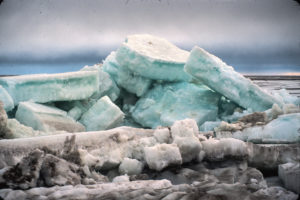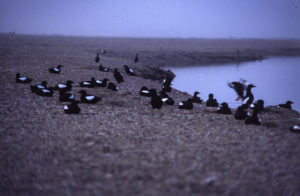Part 13, the ice and wind come to call.

The ice push begins.
2 July
Rainy, windy, cold day yesterday. Rain finally cleared and I banded a few hapless birds. The egg season is slacking off. Dave did a radio patch so George and I could talk, he seems pleased that things are going well.
When I sat up in my sleeping bag this morning, I could see that an ice push was happening on the north shore. There was a low wall of ice forming along the horizon. I had to go check it out, of course. I wandered through the empty colony (the birds are feeding on the ocean) and up to the beach. Massive slabs of ice two and three feet thick were pushed 30 feet or more up on to the beach and piled on top of each other. As I stood there, nothing was moving, and the ice was quiet. I went back to camp for my camera and decided I had to eat. While I was eating, I noticed or thought I did, a change in the ice. By the time I got back to the ice 15 minutes later, a new pile of slabs was on top of the spot where I had been. If I hadn’t had anything to eat, I would have been out on the ice taking photos – and potentially caught in the shift.
Since then, that spot seems to be most active. The wall, the whole length of the north shore is still building impressively. It is probably 25 feet high. Jumbled blocks of ice three thick and six or eight feet square, sheets of thinner ice in massive slabs. Blues of a vivid, ethereal quality, greens of the cold ocean, monoliths of ice that stand for 10 minutes before spinning, sliding, crumbling under the unforgiving pressure behind them.
I spent a long time standing on the edge, watching cracks form in an upright slab, slowly they spread and grew, large chunks would slide or tumble into the water, and the splash would move across the pool. Sometimes a big slab would fall on another slab and crumble into a million smaller pieces. The wind takes most of the sound away but standing close by I could hear the pieces falling. The more solid ice doesn’t sound real; the looser, granular ice sounds like melting snow. Now and then a big rumble breaks free where two slabs are colliding, or a piece has fallen hard onto other ice. I wonder how far it will move?
Well, in the last hour – since I wrote the above – there has been some action. The ice continues to pile drive its way into the beach. There are several places where my tracks from earlier this morning are obliterated. In some places, the wall is 45’ or 50’ high. I can’t see the ocean past the wall at all anymore. The giant tanks to the east of camp have been pushed; one dug into the bank 4’ or 5’. The other was pushed across the surface, probably 10’ or more. I can’t tell any longer where it started. The BGs whose homes were underneath are out of luck, I’m afraid.
The wall is impressive with the sun on it. It runs the length of the island, and with the sun striking from the northeast it fairly glows against the sand and the dark, cloudy sky.
What force can move ice like this? Thousands of pounds of ice being driven over and into the sand with no effort. There is no tide to speak of, no surge of power that would push like this. The wind is strong but not enough to move ice onto land, it might pile it up on the windward side of the bay but not pile drive it 50’ or more from the water’s edge into the sandbanks. Truly awesome power. Again, I feel as insignificant as I am.
The BGs are a bit jumpy. They are spending a lot of time at the roost on the North Shore. Maybe it’s the noise that bothers them. I don’t know. Achoó.
I noticed there were no seals around the last few days. Perhaps they perceived the ice shift and bailed out. Maybe that is why, too, the bear didn’t linger on my paradise island.
Today as I was walking around the pond I had this thought. I was thinking about the feeling you have when the wind gets knocked out of you – when you get hit in the solar plexus or are being tickled until you can’t breathe – and how when air first reaches your lungs again how sweet and exhilarating that breath is. This is the feeling that I have now after being alone, here, for so long.
4 July
Today I feel like I am on an island in the Arctic Ocean. It is relatively mild in temp, but the fog is thick, the air heavy and damp and everything is cold and raw. The ice wall is the limit of my world. The fog fills in the rest, the bay is gone and so too are most of the east and west ends of the island.
I keep thinking the weather will get better but it doesn’t seem to. My toes and fingers are cold and hurt. Working through the night, I hardly see the mild afternoons. When the wind stops, and the air is calm, life is good – even if the temp is low and there are clouds, just the movement of the air is debilitating. So, the paper is physically soggy, and the tent is steamy. It is cold and raw outside. It rained heavily earlier in the night – I stayed in bed and curled up in a ball, tight and warm. The wind switched around to the NE, and the air coming off the pack ice is cold and wintery.
The only thing I miss so far is my light little summer dresses. Those clothes that let you feel like you are wearing nothing. How I love them – It is hard to remember that feeling when you are embedded in many layers of wool, polypro, and nylon. Bleaaachk. Ah well.
The ice push the other day left big ridges and piles of rubble and cut blocks. I thought of Hadrian’s Wall marching across the Arctic Ocean to keep out the Roman hordes – in some places the push really does look like a wall. I went down to the tundra yesterday morning and sketched a little – I’m pretty bad but it is a fun exercise. How do people actually copy what they see and make it recognizable?
5 July
Well, as I was settling into my sleeping bag last night, I thought the rain would let up, and I was sure I would awake to a southwest wind howling. Sure enough. At 0530 the antenna went down and set off the perimeter alarm. I hurled myself out of my dreams and into my boots. As I disconnected the fence, George’s tent went sailing by. I was just able to grab it and heave it into the lee of the wind block I had set up on the NE side of my tent (for the wind and rain that was present when I went to sleep). I secured the cook tent as best I could, reset the windbreaks, and went back to bed. I woke at midnight and listened to the wind. Checked to see if the other tents were still there and then lay in bed and read for a long time. I was finally driven out by a need to pee and to eat. The fly of the cook tent is shredded. Everything in there is thrown about and jumbled – I pulled out P.B. and bread. It’s not possible to cook with it like that. I would even be afraid to start the stove. I reweighted the tent, and still, it tries to migrate north. I threw extra weight in George’s tent last night and in its relatively-wind-blocked place seems fine. This tent, my sleep tent, has a new hole in it where the force of the wind pushed it into my tripod and punctured it. The whole side is collapsing in on me. This wind is by far worse than the first two.
I just went for a walk – it was about all I could do to walk into the wind – I went to the sardine box and hid behind it for a while. The ice of Elson Lagoon is all piled up on the south shore. It has stayed flat and in floes, unlike the jumbled blocks of the north shore. On the north, the rest of the ice pushed in and piled up, and there is open ocean a few hundred yards out and for as far as I can see. Just at the edge is the pack ice, a thin white line. The open water is dark and angry and hurling itself against the ice that still stands out in the shallows, in its path. There is a slurry of smaller chunks and slush that slides along behind the immobile blocks of Hadrian’s Wall. It is moving east rapidly.
The few birds that are moving are doing so either in the screaming delight of going with the wind or the tortured slow motion float of those laboring against it. Few guillemots are out. Some are on the water, but mostly the colony is empty and quiet. There is a flock of oldsquaw heaved out on the edge of the water, bills tucked into their wings.
The water on the south side is as high as I have seen it. That means the atmospheric pressure is as low as it has been since I’m here. The south spit is underwater. I am relatively comfortable in my tent. If the wind lets up a little bit, the collapsing effect is not as pronounced, and I can sit comfortably and read. I have attempted no work and will not, outside the mandatory egg check, and even that won’t be so bad since there are relatively few nests left to check. Many that should have had 2nd eggs yesterday did not. I suppose that means that they will all come in today, but I’ll only note their existence and leave measuring and weighing for another day.
Join me this fall on The Road not Taken Enough when I go to Svalbard on an Arctic Circle residency Artistry in the Arctic.

Black Guillemots lounging poolside.
